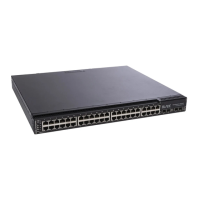© Copyright IBM Corp. 2011 Chapter 10. Spanning Tree Protocols 127
Multiple Spanning Tree Protocol
Note: MSTP is supported in stand-alone (non-stacking) mode only.
Multiple Spanning Tree Protocol (MSTP) extends Rapid Spanning Tree Protocol
(RSTP), allowing multiple Spanning Tree Groups (STGs) which may each include
multiple VLANs. MSTP was originally defined in IEEE 802.1s (2002) and was later
included in IEEE 802.1Q (2003).
In MSTP mode, the G8000 supports up to 32 instances of Spanning Tree,
corresponding to STGs 1-32, with each STG acting as an independent,
simultaneous instance of STP.
MSTP allows frames assigned to different VLANs to follow separate paths, with
each path based on an independent Spanning Tree instance. This approach
provides multiple forwarding paths for data traffic, thereby enabling load-balancing,
and reducing the number of Spanning Tree instances required to support a large
number of VLANs.
Due to Spanning Tree’s sequence of discarding, learning, and forwarding, lengthy
delays may occur while paths are being resolved. Ports defined as edge ports (“Port
Type and Link Type” on page 129) bypass the Discarding and Learning states, and
enter directly into the Forwarding state.
MSTP Region
A group of interconnected bridges that share the same attributes is called an MST
region. Each bridge within the region must share the following attributes:
•
Alphanumeric name
•
Revision number
•
VLAN-to STG mapping scheme
MSTP provides rapid re-configuration, scalability and control due to the support of
regions, and multiple Spanning-Tree instances support within each region.
Common Internal Spanning Tree
The Common Internal Spanning Tree (CIST) provides a common form of Spanning
Tree Protocol, with one Spanning-Tree instance that can be used throughout the
MSTP region. CIST allows the switch to interoperate with legacy equipment,
including devices that run IEEE 802.1D (1998) STP.
CIST allows the MSTP region to act as a virtual bridge to other bridges outside of
the region, and provides a single Spanning-Tree instance to interact with them.
CIST port configuration includes Hello time, Edge port enable/disable, and Link
Type. These parameters do not affect Spanning Tree Groups 1–32. They apply only
when the CIST is used.
MSTP Configuration Guidelines
This section provides important information about configuring Multiple Spanning
Tree Groups:
•
When MSTP is turned on, the switch automatically moves all VLANs to the CIST.
When MSTP is turned off, the switch moves all VLANs from the CIST to STG 1.
•
When you enable MSTP, you must configure the Region Name. A default version
number of 1 is configured automatically.

